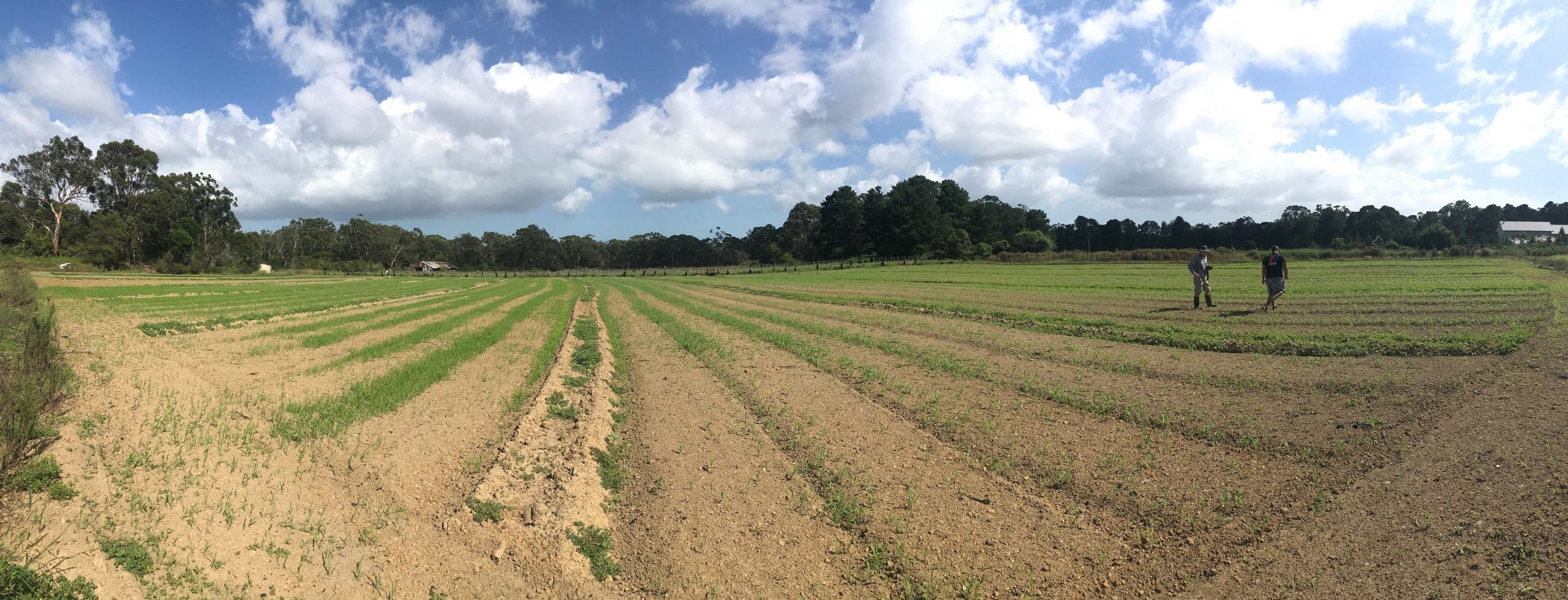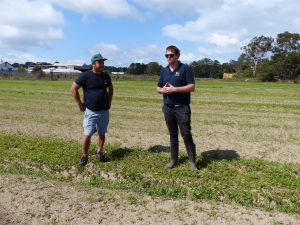NSW grower trials cover crops to eliminate single-use plastic mulch and control weeds
The Soil Wealth and Integrated Crop Protection (ICP) project works with growers nationally to put soil management and plant health research into practice. The project team is currently working with New South Wales vegetable grower Kim Ngov, who is using cover crops to not only build soil health and control weeds, but also eliminate single-use plastic mulch. Soil Wealth ICP Phase 2 (VG16078) is a strategic levy investment under the Hort Innovation Vegetable and Potato Funds.
Grower Kim Ngov has sown another cover crop trial on his intensive vegetable farm near the southwest outskirts of Sydney (Wedderburn, New South Wales). This time Kim is focused on using cover crops to build soil health, control weeds and eliminate single-use plastic mulch.
Four cover crops were sown on 14 February 2021: ryecorn (cereal rye), millet (see Figure 2), sorghum and a mixture of sorghum and ryegrass.
At this stage, a broadleaf herbicide could be used to clean up roadways as well as bird damaged cover crop areas and eliminate weeds like common mallow (Malva parviflora), wireweed (Polygonum aviculare) and common sow thistle (Sonchus oleraceus), which will compete against the cover crops all through the autumn and winter months.
We expect the millet and sorghum areas to self-terminate with the onset of winter. Ryecorn and ryegrass areas will likely need to be mulched down several times, adding to the overall biomass on the soil surface.
Another option Kim has in mind is installing a weed mat later in the season, just before planting chillies in September- October 2021 on a flat surface. The weed mat is a ground cover consisting of a woven polypropylene, needle-punched fabric with reinforced fibre for extra durability.
The cover crops will still recycle nutrients and increase infiltration rates. The five metre width rolls of weed mat – if needed – will lay over the cover crops between the roadways, allow fertiliser to flow into the soil, control weeds, warm the soil and be rolled back up at the end of the season to be re-used multiple times.
You can read more about Kim’s efforts in weed management in a case study that explains how an inter-row ryegrass cover crop was used to control weeds in his snow pea crops.
He also explains more in this short podcast.
Kim Ngov and Pieter Van Nieuwenhuyse from the Soil Wealth ICP team discuss the establishment of the cover crops and options to control weeds.
A trio of integrated weed management fact sheets now available
Is oxalis, volunteer potatoes or nutgrass driving you nuts on-farm?
The Soil Wealth ICP project has put together a series of three fact sheets on priority weed species and their integrated management in vegetables.
- Nutgrass (Cyperus rotundus)
Nutgrass, also known as purple nutsedge, Java grass, coco-grass and red nutsedge, is a major problem for the Australian vegetable industry.
It is extremely invasive under the right conditions (warm, wet soils) and requires planning, diligence and multiple strategies to control it on Australian vegetable farms. An integrated weed management (IWM) strategy, including cultivation measures and chemical control, is the best approach for reducing nutgrass populations to a manageable level.
You can access the fact sheet here.
- Volunteer potatoes (Solanum tuberosum)
Volunteer potatoes are generally the most significant weed problem in the field following a potato harvest. Where it is timed appropriately, an IWM strategy can be very effective in managing this problem when combining proper harvest practices, using appropriate harvest conditions, physical destruction by tillage, weeding or grazing and herbicide application with tillage.
You can access the fact sheet here.
- Oxalis (Oxalis spp.)
There are about 30 species of oxalis in Australia, including soursob and creeping oxalis. More commonly found in the southern parts of Australia, oxalis is an invasive weed of cultivated fields but is also found in no-till situations (e.g. roadsides and native landscapes).
Not to be confused with clover, most oxalis species have three heart shaped leaflets (forming one trifoliate leaf) with smooth edges. Control measures in an IWM strategy should be undertaken prior to flowering stage for soursob and creeping oxalis.
You can access the fact sheet here.

Find out more
For more information, please contact project leaders Dr Gordon Rogers on 02 8627 1040 or gordon@ahr.com.au and Dr Anne-Maree Boland on 03 9882 2670 or anne-mareeb@rmcg.com.au.
This project has been funded by Hort Innovation using the vegetable, fresh potato and processing potato research and development levies and contributions from the Australian Government.
Project Number: VG16078
Cover image: Vegetable grower Kim Ngov and Marc Hinderager from the Soil Wealth ICP team inspect the different cover crops at an early stage.


